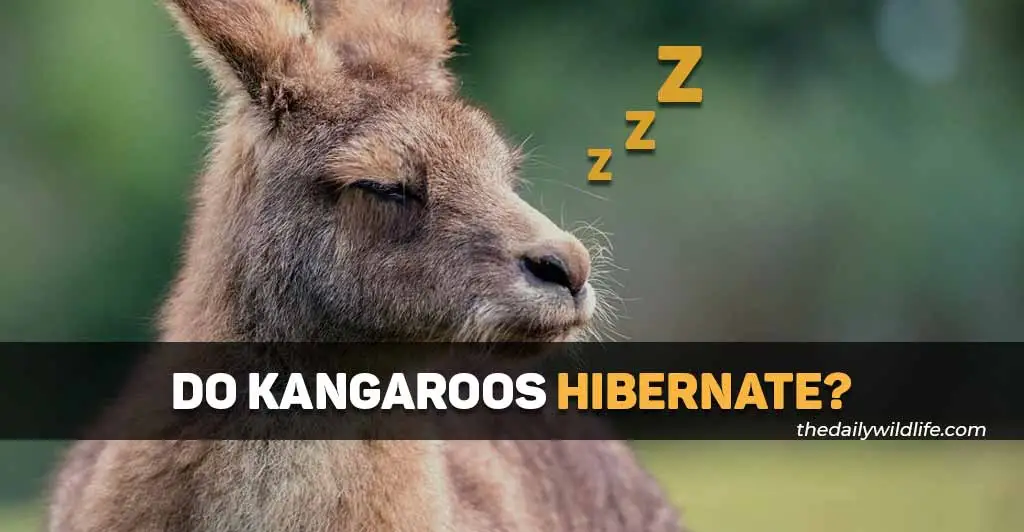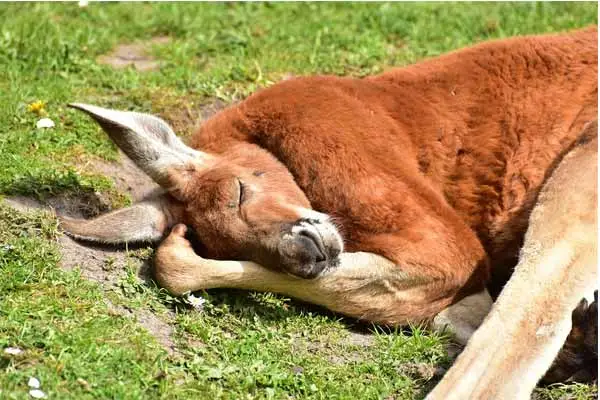Kangaroos, famous for hopping and bouncing on their hind legs, live both in the wild and in captivity. In the US, for example, you can visit these magnificent beasts at the Columbus Zoo, Lincoln Park Zoo, Denver Zoo, and many others.
If you ever visited kangaroo enclosures during winter, you probably know that captive kangaroos in zoos do not hibernate. Their enclosures are well-protected from the outside cold.
But do wild kangaroos hibernate when the winter months come upon them?
No, kangaroos do not hibernate; neither in the wild nor in captivity. There are no species of kangaroo that hibernates.
This great question deserves a thorough answer, though.
Let’s take a deeper look, explain the main reasons why kangaroos do not hibernate, and examine if they migrate or estivate instead.

Table of Contents
Kangaroos Do Not Hibernate, Here’s Why
Hibernation is a state of deep sleep an animal enters to conserve energy and survive when food is scarce and the temperature is too low.
Most of the time, this happens during the winter months when there is no food around, so the animal decides to drop its body temperature, heart rate, and breathing rate to extremely low levels to conserve energy.
Kangaroos do not hibernate because they live in dry woodlands, deserts, and grasslands. These are all places that do not have much snow or extremely cold temperatures so kangaroos do not need to hibernate.
The red kangaroo, the largest of all kangaroos and the largest terrestrial mammal native to Australia, can be found in most of the central part of mainland Australia. The region has a desert climate. During the winter months, the average maximum is around 77°F, dropping toward 32°F overnight.
The Eastern gray kangaroo, the second largest and heaviest marsupial in Australia, can be found in semi-arid grasslands and open woodlands of Tasmania and Eastern Australia. In Tasmania, for example, winter runs from May to August, and temperatures generally fall between 37°F and 51°F.
These are cold winters, but not that extreme to require hibernation. Kangaroos don’t seem to be bothered by such semi-cold temperatures.
In 2019 however, kangaroos experienced rare snow in three south-eastern Australian states. After strong winds and freezing winter conditions swept across, kangaroos could be seen shivering under such conditions.
Observers said that the “resident kangaroos were not enjoying the snow as much as they were.”
Do Kangaroos Migrate?
No, kangaroos do not migrate.
Most kangaroo species are fairly sedentary, with groups living in a persistent home range rather than being migratory or nomadic.
In some species, like the inland red kangaroo, males might occasionally move large distances in search of better mating opportunities, food, and water during drought, or to establish territories far from where they were born. Females usually remain where they were born.
If we look at the definition, it says that animal migration “is the regular, usually seasonal, movement of all or part of an animal population to and from a given area.” The key part here is “seasonal”.
Kangaroos do not seasonally move their populations; they remain in their home range. This is why we can conclude that kangaroos do not migrate (make annual, repetitive, two-way trips).
Do Kangaroos Get Into Torpor?

No, kangaroos are animals that do not enter torpor to survive harsh conditions.
Torpor is a hibernation-like state of sleep where an animal lowers its body temperature, breathing rate, heart rate, and metabolic rate to survive the winter months.
Unlike hibernation, torpor is an involuntary state that an animal enters into, and lasts a lot shorter.
Animals that go into torpor are some species of birds (like hummingbirds), raccoons, skunks, some mice, and bats.
Do Kangaroos Estivate?
No, kangaroos do not estivate.
Aestivation or estivation is a state of sleep similar to hibernation that takes place during the hot and dry summer months. Estivation is characterized by a period of inactivity and a lowered metabolic rate.
Summers in the parts of Australia where kangaroos live can be intensely hot with daytime temperatures often reaching well over 105°F.
Despite living in areas that can have extremely high summer temperatures, kangaroos do not estivate. They remain active throughout the year.
To cool down, kangaroos will rest under trees or shrubs during the heat of the day, and come out to feed in the cool of the evening and at night.
Animals that go into estivation are mollusks, crabs, crocodiles, some salamanders, mosquitoes, desert tortoises, the dwarf lemur, and some hedgehogs, but not kangaroos.
Read More: Does A Penguin Hibernate Or Migrate When The Winter Comes?
Final Thoughts – Do Kangaroos Hibernate?
Kangaroos are the largest terrestrial mammals in Australia and the only large animals that move around by hopping. They are warm-blooded mammals that do not hibernate or enter any other state of dormancy. Instead, they remain active during winter and summer.
Just like other animals, kangaroos neither get into torpor nor do they aestivate – they survive colder weather by staying active.
Some kangaroo individuals have been recorded moving 9-60 miles to places where there’s food and water available.
One modern aerial study has given some evidence for the existence of long-distance movement among kangaroos suggesting that some seasonal movements can be detected with broad-scale aerial surveys. Still, more studies and concise conclusions are available on this topic.
If you were pondering on the question “do kangaroos hibernate or migrate”, we hope this article removed all doubts.
And if you enjoyed it, feel free to read another popular read on animal hibernation: Do elephants hibernate or migrate during winter?